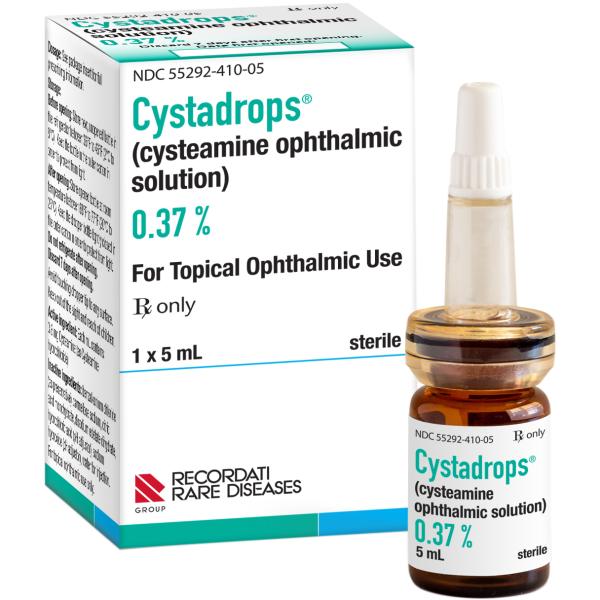Cysteamine ophthalmic
Generic name: cysteamine ophthalmic [ sis-TEE-a-meen-off-THAL-mik ]
Brand names: Cystadrops, Cystaran
Dosage form: ophthalmic solution (0.37%; 0.44%)
Drug class: Miscellaneous ophthalmic agents
What is cysteamine ophthalmic?
Cysteamine works by reducing the amount of cystine (an amino acid) in the body. Cysteamine is used in people with cystinosis (SIS-tin-OH-sis), a rare genetic condition that causes a build-up of cystine in the kidneys and other organs, including the eyes.
Cysteamine ophthalmic (for the eyes) is used to keep cystine crystals from building up in the cornea (surface of the eye).
Cysteamine ophthalmic may also be used for purposes not listed in this medication guide.
Cysteamine ophthalmic side effects
Get emergency medical help if you have signs of an allergic reaction: hives; difficult breathing; swelling of your face, lips, tongue, or throat.
Cysteamine ophthalmic may cause serious side effects. Call your doctor at once if you have:
-
increased pressure inside the skull--severe headaches, ringing in your ears, dizziness, nausea, vision problems, pain behind your eyes.
Common side effects of cysteamine ophthalmic may include:
-
eye pain, redness, itching, or irritation;
-
vision problems;
-
headache; or
-
increased sensitivity to light.
This is not a complete list of side effects and others may occur. Call your doctor for medical advice about side effects. You may report side effects to FDA at 1-800-FDA-1088.
Related/similar drugs
Warnings
Follow all directions on your medicine label and package. Tell each of your healthcare providers about all your medical conditions, allergies, and all medicines you use.
Before taking this medicine
Tell your doctor if you are pregnant or breastfeeding.
Cysteamine is not approved for use by anyone younger than 18 years old.
How should I use cysteamine ophthalmic?
Follow all directions on your prescription label and read all medication guides or instruction sheets. Use the medicine exactly as directed.
Do not take by mouth. Cysteamine ophthalmic is for use only in the eyes.
Cystaran is usually used once every hour while you are awake. Cystadrops are usually applied 4 times per day. Follow your doctor's dosing instructions very carefully.
Do not use while wearing soft contact lenses. A preservative in cysteamine ophthalmic could permanently stain the lenses. Use the medicine at least 15 minutes before inserting your contact lenses.
Wash your hands before using eye medication.
To apply the eye drops: Tilt your head back slightly and pull down your lower eyelid to create a small pocket. Hold the dropper above the eye and squeeze a drop into this pocket. Close your eyes for 1 or 2 minutes.
Use only the number of drops your doctor has prescribed.
Do not touch the tip of the eye dropper or place it directly on your eye. A contaminated dropper can infect your eye, which could lead to serious vision problems.
Storing cysteamine ophthalmic:
-
Keep the bottle in the original carton.
-
Store Cystaran in a freezer until you are ready to start using it. Thaw for 24 hours before your first use, then store the bottle tightly closed in a refrigerator or at room temperature. Do not refreeze after thawing.
-
Store Cystadrops in a refrigerator. After first opening the bottle, store it in a refrigerator or at room temperature tightly closed and protected from light. Do not refrigerate after opening the bottle.
Throw the bottle away after 1 week of use, even if there is still medicine inside. If using Cystaran, remove a new bottle from the freezer in time to allow 24 hours for thawing so you will not miss a dose.
Cysteamine ophthalmic dosing information
Usual Adult Dose for Corneal Cystine Crystal Accumulation:
Instill one drop in each eye every waking hour; discard after 1 week of use.
Use: Treatment of corneal cystine crystal accumulation in patients with cystinosis.
Usual Pediatric Dose for Corneal Cystine Crystal Accumulation:
Instill one drop in each eye every waking hour; discard after 1 week of use.
Use: Treatment of corneal cystine crystal accumulation in patients with cystinosis.
What happens if I miss a dose?
Use the medicine as soon as you remember, and then go back to your regular schedule. Do not use two doses at one time.
What happens if I overdose?
An overdose of cysteamine is not expected to be dangerous. Seek emergency medical attention or call the Poison Help line at 1-800-222-1222 if anyone has accidentally swallowed the medication.
What should I avoid while using cysteamine ophthalmic?
Your dose needs may change if you switch to a different brand or strength of cysteamine ophthalmic. Avoid medication errors by using only the form and strength your doctor prescribes.
What other drugs will affect cysteamine ophthalmic?
Medicine used in the eyes is not likely to be affected by other drugs you use. But many drugs can interact. Tell each of your healthcare providers about all medicines you use, including prescription and over-the-counter medicines, vitamins, and herbal products.
More about cysteamine ophthalmic
- Compare alternatives
- Side effects
- Dosage information
- During pregnancy
- Drug class: miscellaneous ophthalmic agents
- En español
Patient resources
Other brands
Professional resources
Other brands
Related treatment guides
Further information
Remember, keep this and all other medicines out of the reach of children, never share your medicines with others, and use this medication only for the indication prescribed.
Always consult your healthcare provider to ensure the information displayed on this page applies to your personal circumstances.
Copyright 1996-2025 Cerner Multum, Inc. Version: 3.01.

